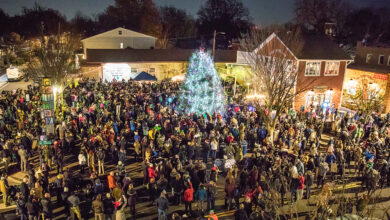Del Ray Art Deco Architecture Walking Tour
Art Deco was one of most distinctive architectural styles of the 20th century. Alexandria has relatively few of these buildings, but many of them are in Del Ray.

(Photos: Bill Hendrickson)
By Bill Hendrickson
Alexandria, VA – Art Deco was one of most distinctive architectural styles of the 20th century. Alexandria has relatively few of these buildings, but many of them are in Del Ray.
Now you can learn more about these buildings in a Del Ray Art Deco Walking Tour featuring 16 structures built between the 1920s and 1950s. They include commercial buildings, warehouses, a public utility building, garden apartments, and a school.
The tour takes place largely on or just off Mount Vernon Avenue. Indeed, the construction of key buildings on the tour reflects the Avenue’s rise as a vital commercial corridor in Alexandria.
The tour is based on research done by architectural historian Heather McMahon. The City hired McMahon in 2014 to research Del Ray’s Art Deco buildings and prepare applications for nomination to the National Register of Historic Places. These applications are available in the Historic Preservation section of the Department of Planning and Zoning on the City’s website (alexandriava.gov).
Three buildings on the tour are contributing resources to the Town of Potomac National Register Historic District, which was established in 1992 and consists of late 19th and early 20th century subdivisions in what is now Del Ray.
National Register status lends prestige to a neighborhood, but it is an honorific, not a legal designation. None of the buildings on the tour are legally protected and could potentially be demolished. Indeed, one building that McMahon researched already has been.
The modernistic style that came to be called Art Deco was the rage across the United States in the 1920s and 1930s, and continued to be used into the 1950s. Although Del Ray’s Art Deco buildings are modest in design, the finest examples of the style combined modern aesthetics, fine craftsmanship, and expensive materials, and became the symbol of luxury and modernity.
(Photos: Bill Hendrickson)
The most architecturally distinctive Art Deco building on the tour is George Washington High School (now middle school), with its striking central pavilion, grand staircase, and richly decorated stonework. The original school was built between 1934 and 1935, but there have been several additions, including the Art Deco-style Mechanical Arts Building to the south, which was originally a standalone structure but later connected.
The school was funded by the federal government, as were many other schools during the Great Depression. And many featured Art Deco elements. “Art Deco radiated an aura of modernity and an optimism that befitted the Roosevelt administration’s vision for a new America,” McMahon writes.
The school illustrates two defining features of Art Deco architecture: an emphasis on verticality and and often unique ornamentation. Check out, for example, the stylized eagles at the top of the central entrance on Mount Vernon Avenue and the machine cogs and compasses carved into the original entrance of the Mechanical Arts Building.
Other highlights of the Del Ray Art Deco walking tour are a warehouse building at 501 East Monroe Ave. (currently Swings Coffee) and four similarly designed warehouses on Leslie Avenue.
Noted Washington, D.C., architect William St. Cyr Barrington designed 501 East Monroe. The Leslie Avenue warehouses were designed by others, but clearly are based on Barrington’s designs for the East Monroe building. James Juliano built all five buildings in 1952 and 1953.
Warehouse buildings typically are basic, mundane structures. But these buildings, McMahon says, are not only some of the finest examples of Art Deco in the area, but perhaps rare examples of industrial buildings in which so much attention has been paid to architectural quality.
Barrington’s design, she writes, “monumentalized the structure [of 501 East Monroe Ave.] and its banal purpose through the use of decoration and exquisite detailing.” McMahon says that the significant use of stone can be attributed to Juliano, the son of an Italian stonemason who immigrated to Philadelphia in the late 1800s. Juliano’s buildings “reflect a continued interest in stone masonry and Italian craft traditions,” she writes.
Perhaps the most distinctive design element at 501 East Monroe Ave. is the decorated stone pilaster separating the two doors of the central entrance. It is carved like a fluted Ionic column and topped by the visage of a Native American.
A different kind of Art Deco building is Bowman’s Drugstore at 2213 Mt. Vernon Ave. (most recently Bean Creative). This type of building is often characterized as Streamline or Art Moderne, which can be considered either a variety of Art Deco or a style of its own. Streamline Moderne stressed horizontality rather than verticality and featured less ornamentation than Art Deco.
(Photos: Bill Hendrickson)
Built in 1941 by pharmacist Clayton L. Bowman to serve as his drugstore and home, the building includes classic features of the Streamline Moderne style. Note especially the rounded shape of the building, the continuous curved ribbon windows on the second floor above the main entrance, and the rows of soldier bricks that help to emphasize the building’s horizontality. Best feature of all: at the main entrance, a curved, banded aluminum canopy is supported by fluted Doric pilasters made of aluminum.
“The exceptionally high quality of the Streamline Modern style that it exhibits stands out from the surrounding fabric,” McMahon writes.
Other buildings on the tour include the Chesapeake and Potomac Telephone Co. of Virginia (currently Verizon) building at 1316 Mt. Vernon Ave., the Palm Theater building at 2402 Mt. Vernon Ave., the Poladian building, 2411-2419 Mt. Vernon Ave., and the Henry Knox Field Masonic Lodge Building (also the Potomac Station branch of the U.S. Postal Service) at 1908 Mt. Vernon Ave.
Bill Hendrickson is former president of the Del Ray Citizens Association and former chair of the Historic Alexandria Resources Commission.
ICYMI: First Thursday: Porch Parties Keep the Tradition Going!







I Gladto read about the Del Ray Art Deco tour but disappointed that there’s not a more detailed, stop by stop listing. The citizen’s Association has nothing that I could find.
The tour has now been linked–please see article above again. Our apologies on the delay in getting it linked.